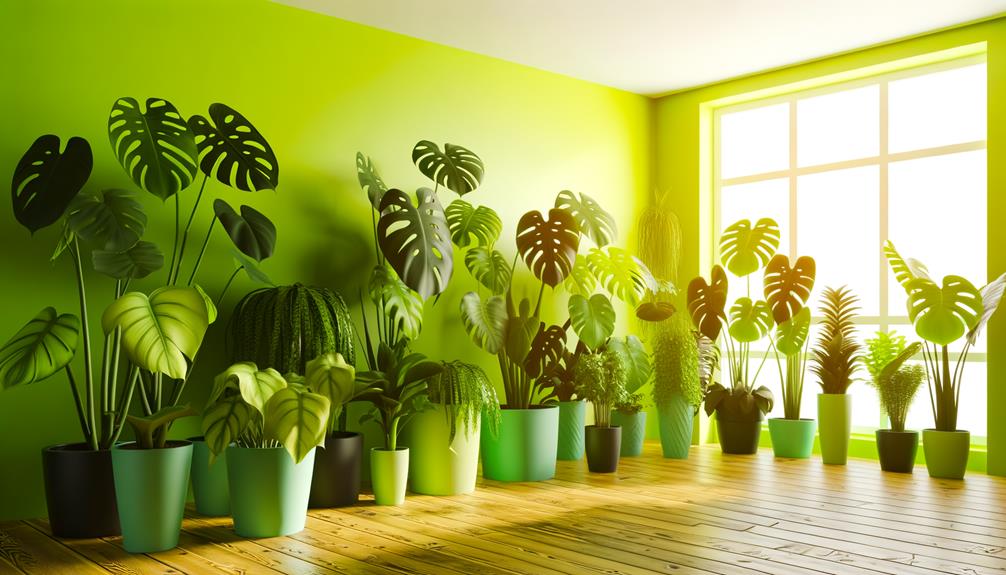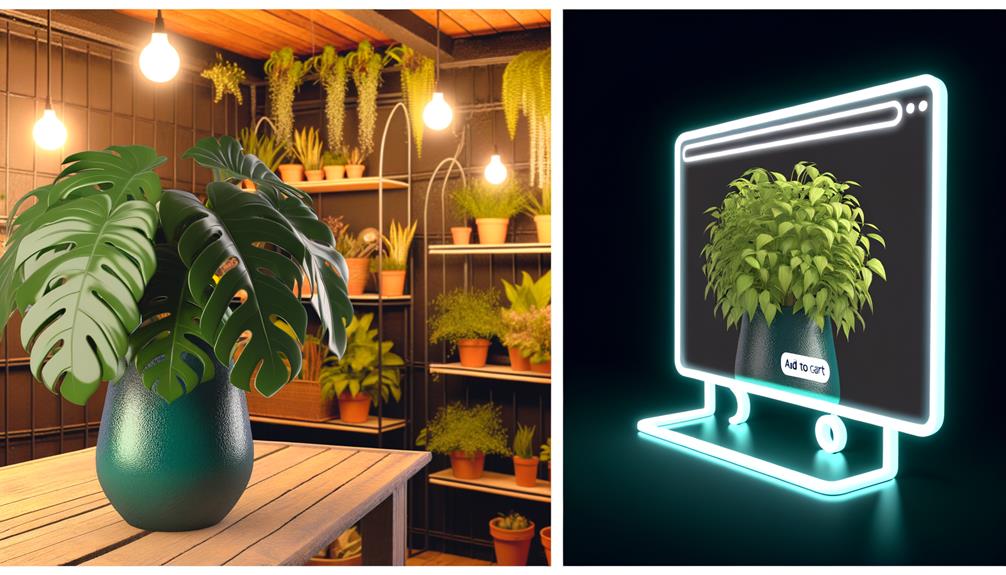How Much Is A Monstera Plant In 2024?
The price of a Monstera Adansonii plant in 2024 can vary depending on factors such as the size of the plant, variegation, and the seller.
Here are some prices from various sellers:
| Seller/Platform | Price |
|---|---|
| The Old Yew Plant Shop | $28.00 |
| PlantVine | $28.00 |
| Etsy | $52.50 |
| Humboldt Houseplants | $0.00 USD (initially shown, actual price not available) |
It is worth noting that Monstera Adansonii is generally less expensive than some of the more unique and rare Monstera varieties. Those prices can range from $500 to $5,000, as seen in the case of the Monstera Deliciosa ‘Albo-Variegata’ and Monstera Deliciosa ‘Creme Brulee’ variants.
Seasonal demand can also drive prices up, particularly during summer and the holiday season. Explore further to understand the detailed nuances affecting Monstera plant pricing.

Key Takeaways
- Monstera plant prices range from $50 to over $3,000 depending on rarity and features.
- Larger, mature Monstera plants with more fenestrations are generally more expensive.
- Rare varieties like Monstera Albo and Thai Constellation command higher prices.
- Online purchases may offer competitive pricing but carry shipping risks.
- Seasonal trends like summer growth and holiday demand spikes can affect Monstera prices.
Factors Influencing Price

When evaluating Monstera plant prices, considering factors such as plant maturity, rarity, and overall health is crucial.
You should understand that rarer Monstera varieties, like the Monstera Albo or Monstera Thai Constellation, command higher prices due to their unique variegation patterns and limited availability.
Additionally, a plant’s overall health strongly impacts its price. A Monstera exhibiting vibrant, unblemished leaves and robust root systems will be more valuable compared to one with signs of disease or pest infestation.
Keep in mind that a well-maintained plant can also reflect the care and effort invested, further justifying a higher price.
Size and Age
The size and age of a Monstera plant directly correlate with its market price, as larger and more mature plants often demand higher prices due to their established root systems and fuller foliage. When you’re evaluating a Monstera, consider its leaf count, leaf size, and overall height.
Mature plants typically have more fenestrations natural splits in the leaves indicating a robust growth phase. Younger plants, while less expensive, require more time and care to reach maturity. Root systems in older plants are more developed, contributing to better nutrient uptake and stability. These factors collectively increase the plant’s value.
If you’re seeking a lush, visually impactful Monstera, prepare for higher costs compared to a younger, smaller specimen.
Common Varieties

You’ll find that Monstera plants come in various types, each with unique characteristics impacting their price.
Popular varieties like Monstera deliciosa and Monstera adansonii are more accessible and affordable, whereas rare types such as Monstera obliqua command higher prices due to their scarcity.
Understanding these distinctions will help you make informed decisions when purchasing.
Popular Monstera Types
Among the popular Monstera varieties, you’ll find the Monstera deliciosa, known for its eye-catching split leaves and rapid growth rate. This variety thrives in indirect sunlight and needs well-draining soil to prevent root rot.
Another common type is the Monstera adansonii, distinguished by its smaller, perforated leaves. It’s more compact, making it ideal for smaller spaces.
You might also come across the Monstera siltepecana, notable for its silvery leaves with dark green veins. This plant prefers higher humidity levels and regular watering.
Each of these varieties has specific care requirements, which can impact their growth and appearance. Understanding these nuances helps guarantee your Monstera stays vibrant and healthy, maximizing its ornamental value in your indoor garden.
Rare Varieties
Collectors and enthusiasts often seek rare Monstera varieties like Monstera obliqua and Monstera adansonii variegata for their unique foliage and striking patterns. These plants are not just visually appealing but also present a challenge due to their specific care requirements. The rarity and demand for these varieties greatly affect their prices.
Here’s a quick look at some rare Monstera varieties and their typical price ranges:
| Monstera Variety | Average Price Range | Key Features |
|---|---|---|
| Monstera obliqua | $1,000 – $3,000+ | Extremely fenestrated leaves |
| Monstera adansonii variegata | $500 – $1,500 | Variegated leaves with white patches |
| Monstera deliciosa Albo | $300 – $1,000 | White and green marbled leaves |
| Monstera Thai Constellation | $200 – $700 | Creamy variegation on large leaves |
| Monstera siltepecana | $50 – $150 | Silver markings on elongated leaves |
Understanding these factors can help you navigate the market effectively.
Retail Vs. Online

When you’re looking to buy a Monstera plant, understanding the differences between retail and online purchasing can greatly impact your selection, cost, and overall satisfaction. Retail stores offer the advantage of seeing the plant’s condition firsthand, yet they often come with higher prices due to overhead costs.
Online purchasing, on the other hand, provides a broader selection and competitive pricing but comes with risks like shipping damage and misrepresentation.
Key considerations include:
- Quality Control: Retail allows for immediate inspection, whereas online relies on seller honesty.
- Price Variability: Online options might be cheaper, but shipping fees can add up.
- Convenience: Online shopping is more convenient, but retail offers instant gratification.
- Risk Factor: Online purchases carry the risk of receiving unhealthy plants.
Understanding these factors helps you make an informed decision.
Nursery Vs. Private Seller
Choosing between a nursery and a private seller for your Monstera plant requires a careful analysis of factors like plant health, authenticity, and pricing.
Nurseries often provide standardized care, ensuring healthier plants due to controlled environments and expert handling. They also offer authenticity guarantees, reducing the risk of misidentified species. However, nurseries might charge higher prices due to these assurances.
Conversely, private sellers can offer competitive pricing, but the plant’s health might vary significantly. You’ll need to assess the seller’s reputation and the plant’s condition meticulously.
While you might find rare Monstera varieties through private sellers, the lack of professional oversight can lead to potential issues.
Weigh these pros and cons to make an informed decision that balances cost and quality.
Seasonal Pricing

When analyzing Monstera plant prices, you’ll notice significant seasonal variations. Winter months often lead to price fluctuations due to limited growth and supply, while summer sees a demand surge as more people seek to enhance their gardens.
Additionally, holiday seasons like Christmas can cause trends in pricing, reflecting increased gifting demand.
Winter Price Fluctuations
Winter often triggers a noticeable dip in the price of Monstera plants due to decreased demand and limited growth during colder months. This seasonal pricing trend is influenced by several key factors.
- Reduced Growth Rates: Monstera plants enter a dormant phase, slowing their development, which diminishes their immediate attractiveness.
- Lower Consumer Demand: Cold weather typically reduces interest in acquiring new plants.
- Increased Supply: Nurseries may offload surplus stock to minimize holding costs during the slow season.
- Transportation Challenges: Cold conditions can complicate shipping, prompting suppliers to discount plants to secure sales.
Understanding these dynamics can help you anticipate the best times to buy or sell Monstera plants, potentially securing better deals during winter. This insight is essential for informed purchasing decisions.
Summer Demand Surge
During the summer months, the demand for Monstera plants surges dramatically due to their increased growth rates and heightened consumer interest in indoor greenery. You’ll find that growers capitalize on this period by adjusting prices upwards.
This is primarily because Monstera plants thrive in warm temperatures and long daylight hours, accelerating their growth and making them more appealing.
Retailers often experience stock shortages, further driving up prices. Additionally, the increased demand coincides with a peak in home decor activities, where consumers prioritize lush, vibrant plants. You should anticipate higher prices during this time and plan purchases accordingly.
To minimize costs, consider buying cuttings or smaller plants early in the season before the full surge impacts the market.
Holiday Season Trends
As the holiday season approaches, Monstera plant prices often fluctuate due to a complex interplay of factors such as festive demand spikes and limited retailer inventories.
You’ll notice a distinct pattern:
- Increased Demand: People buy plants as gifts, driving up prices.
- Limited Supply: Retailers may struggle to restock quickly, causing scarcity.
- Promotional Offers: Some stores might offer holiday discounts, affecting pricing dynamics.
- Shipping Delays: Seasonal logistics can impact supply chains, leading to price adjustments.
Understanding these variables helps you anticipate price changes. Retailers often capitalize on holiday sentiments, making it essential to buy early or compare prices across multiple sellers.
Recognizing these trends allows you to make informed purchasing decisions, ensuring you get the best value for your Monstera plant.
Care and Maintenance Costs
Proper care and maintenance of a Monstera plant involve regular watering, occasional fertilizing, and monitoring for pests, all of which can cumulatively affect your overall expenses.
You’ll need to take into account the cost of water, fertilizers, and possibly pest control treatments. Additionally, maintaining ideal humidity and light conditions can require investments in equipment like humidifiers or grow lights.
Here’s a breakdown of potential expenses:
| Category | Frequency | Estimated Cost |
|---|---|---|
| Water | Weekly | $5/month |
| Fertilizer | Monthly | $10/month |
| Pest Control | As Needed | $15/treatment |
| Humidity/Lighting | Initial + Ongoing | $50+ $5/month |
Budget-Friendly Tips

While the costs associated with Monstera plant care can add up, there are several budget-friendly strategies that can help you manage these expenses effectively.
- Propagate your Monstera through cuttings to expand your collection without buying new plants.
- Make your own soil mix using affordable ingredients like perlite and peat moss.
- Use household items as plant supports instead of purchasing expensive stakes or trellises.
- Finally, monitor local plant swaps or online communities for free or inexpensive cuttings.
Conclusion
Think of buying a Monstera plant like acquiring a piece of art. The canvas, whether large or small, common or rare, influences its worth.
Just like choosing between a gallery (nursery) or an online auction, your purchasing avenue shapes the price.
Seasons change, and so do costs. Remember, true value isn’t just the initial price tag but also the care and upkeep.
Bargain wisely, and your leafy masterpiece will thrive, painting your space with nature’s elegance.






